
Washington State University researchers developed a carbon-negative concrete formula by infusing cement with biochar, reducing the industry’s carbon emissions. This environmentally friendly concrete reaches strength comparable to regular cement while absorbing up to 23% of its weight in CO2 from the air.
Washington State University researchers have developed a carbon-negative, eco-friendly concrete formula that is almost as strong as traditional concrete.
In a proof-of-concept work, the researchers at Washington State University infused standard cement with biochar, a type of charcoal produced from organic waste, which had previously been fortified with concrete wastewater. The biochar was able to absorb up to 23% of its weight in carbon dioxide from the atmosphere, yet still maintained a strength comparable to regular cement.
The research could significantly reduce carbon emissions of the concrete industry, which is one of the most energy- and carbon-intensive of all manufacturing industries. The work, led by doctoral student Zhipeng Li, was reported on April 10 in the journal, Materials Letters.
“We’re very excited that this will contribute to the mission of zero-carbon built environment,” said Xianming Shi, professor in the WSU Department of Civil and Environmental Engineering and the corresponding author on the paper.
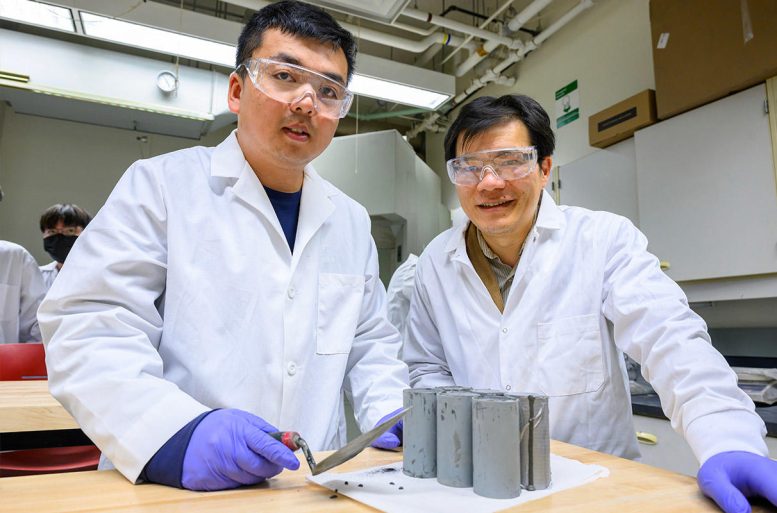
Graduate student Zhipeng Li and Professor Xianming Shi. Credit: Washington State University
More than 4 billion tons of concrete are produced every year globally. Making ordinary cement requires high temperatures and the combustion of fuels. The limestone used in its production also goes through decomposition which produces carbon dioxide, so that cement production is thought to be responsible for about 8% of total carbon emissions by human activities worldwide.
Researchers have tried adding biochar as a substitute in cement to make it more environmentally friendly and reduce its carbon footprint, but adding even 3% of biochar dramatically reduced the strength of the concrete. After treating biochar in the concrete washout wastewater, the WSU researchers were able to add up to 30% biochar to their cement mixture. The paste made of the biochar-amended cement was able to reach a compressive strength after 28 days comparable to that of ordinary cement of about 4,000 pounds per square inch.
“We’re committed to finding novel ways to divert waste streams to beneficial uses in concrete; once we identify those waste streams, the next step is to see how we can wave the magic wand of chemistry and turn them into a resource,” said Shi. “The trick is really in the interfacial engineering – how you engineer the interfaces in the concrete.”
The caustic concrete washout water is a sometimes problematic waste material from concrete production. The wastewater is very alkaline but also serves as a valuable source of calcium, said Shi. The researchers used the calcium to induce the formation of calcite, which benefits the biochar and eventually the concrete incorporating the biochar.
“Most other researchers were only able to add up to 3% biochar to replace cement, but we’re demonstrating the use of much higher dosages of biochar because we’ve figured out how to engineer the surface of the biochar,” he said.
The synergy between the highly alkaline wastewater that contains a lot of calcium and the highly porous biochar meant that calcium carbonate precipitated onto or into the biochar, strengthening it and allowing for the capture of carbon dioxide from the air. A concrete made of the material would be expected to continue sequestering carbon dioxide for the lifetime of the concrete, typically 30 years in pavement or 75 years in a bridge.
In order to commercialize this technology, the researchers have been working with the Office of Commercialization to protect the intellectual property and have filed a provisional patent application on their carbon-negative concrete work. They recently received a seed grant from the Washington Research Foundation to produce more data for a variety of use cases. They are also actively seeking industry partners from the building and construction sector to scale up production for field demonstrations and licensing this WSU technology.
Enter your journal: Reference: “Towards sustainable industrial application of carbon-negative concrete: Synergistic carbon-capture by concrete washout water and biochar” by Zhipeng Li and Xianming Shi, 10 April 2023, Materials Letters.
DOI: 10.1016/j.matlet.2023.134368

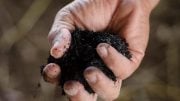

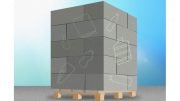


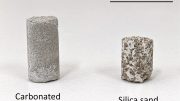

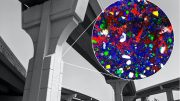
Fantastic news to hear they have developed an alternative to reducing cement’s overall impact on the Enviroment. However I can’t see how it is producing Carbon Negative Concrete. If it can absorb 23% of its weight and you are substituting 30% of the cement with Biochar what happens to the other 595kgCO2e of the cement? It would have to displace more to make it negative.
With a strength of 4,000 PSI or 27 mpa there are alternative cement free options that have high strengths and far less carbon impacts. eg Cemfree
Whatever is done to implement these ideas to capture CO2 and lower CO2 emissions will require transportation that only conventional vehicles can currently provide. This alone will mean gasoline and renewable biofuels in those vehicles that will increase CO2, not lower it. So, will there be a net gain or loss at the end? Never mind the total costs.